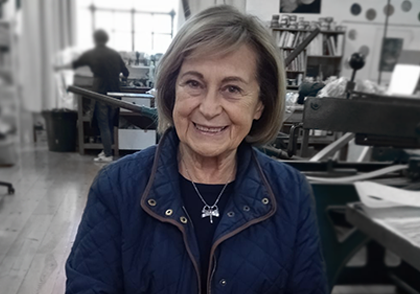
Margarida Lourenço
Margarida Lourenço presents in works that mark her debut at CPS, knowledge and the art of masterfully combining several techniques: digital printing, screen printing, collage and engraving. This fully justifies the cover highlight in the CPS Winter 2021 "arte" magazine, which also stands out for praising the mastery and detail of Atelier CPS in printing the editions.
Margarida Lourenço is Born in Lisbon, with a degree in Mathematical Sciences. He also trained in drawing and painting, but it was in Engraving, in its multiple technical possibilities, that he developed his artistic skills, being a member of the Engraving Association Água-Forte.
This series edited by the CPS, punctuated by the diptych, interconnects in the careful observation of nature, in its poetics, in the value of manuality and in the praise of paper, as a privileged support. We interviewed the artist in one of her preferred environments: Atelier CPS.
What importance do you attribute to the different techniques used in the production of multiple art, in the context of your work?
They are all equally important in the context of my work.
The possibility of combining different techniques such as classical engraving (etching, water -ink, chine collé, black manner, etc.) or contemporary (such as additive techniques and photopolymer), screen printing, digital printing and collage allows enormous creative freedom, in the construction phase of an image that could generate an edition of multiple art.
At CPS I found an excellent technical team; technology, with artistic direction by Alexandra Silvano and the CPS Atelier where you can use both old calcography and lithography presses, as well as the most up-to-date screen printing and digital printing equipment. In these exceptional circumstances in which the dialogue between author and technical team flows naturally, the conditions are created for the production of multiple art editions of high artistic quality.
These editions are based on an identical lived theme: the careful observation of nature. What is its context and relevance to current times?
In my frequent wanderings in the middle of nature that is my favorite. Nearby, namely in São Martinho do Porto, I observe things as simple as the way trees and plants grow, how they connect and seem to communicate with each other. I observe how they reveal themselves with the first light of dawn, often shrouded in fog, and I feel the beauty of the moment as if suspended in time. I feel like I'm part of that nature and that I'm not outside of it, at least at that moment.
But nature is there. to be destroyed by Man through ignorance, carelessness or greed, not seeing that destroying nature destroys itself.
É It is urgent that the defense of nature be disseminated, understood, felt and practiced by everyone!
They also denote an aesthetic look of proximity. Does it make sense to evoke traditional Japanese culture, in its sacred and most contemplative sense?
Of course yes. In an increasingly urgent way, love and respect for nature in traditional Japanese culture should be an example to follow.
In Japanese poetry about nature, I particularly like Matsuo Bashô (1644-1694). Assário e Alvim published “The Traveling Hermit” by Matsuo Bashô (Haikus-Complete work).
Haikus is; a triplet of 5-7-5 syllables in which Bashô will bring to the foreground of your verses everything that even there was despised: frogs side by side with tigers, creeping herbs as respected as chestnut trees, marigolds as marveling as plum blossoms. É It is on this basis of global, holistic inclusion that he locates the source from which his poems naturally flow.
He used different papers: Tiepolo from Fabriano, Japanese Guinwashi and handcrafted from Nepal. How does paper, as a support, reflect your purposes?
When I look for the essence of the images, the choice of handmade paper made with vegetable fibers is essential. fundamental part of my work, being closely linked to nature themes.
In handling it I feel that, just like a lichen, it is a symbiosis of a fungus with an algae, the paper and my work form a symbiosis giving rise to the final work.
Japanese Ginwashi and Kinwashi papers are made from kozo and Manila hemp fibers, with fiber inclusions on one side and smooth on the other. Nepal's Lokta paper is done to hand with inner fibers of evergreen shrubs.
Soft. Intense, deep colors. With burrs. Lokta paper can last for several millennia (2000-3500 years).
What does it look like? Does direct contact with art contribute to the improvement of contemporary society?
Materialism, the economic situation, competitiveness, the speed of technological evolution, the demand for personal and professional success, loneliness, characteristics of Contemporary society can be stressful and demotivating factors. On the other hand, direct contact with art can help free the spirit and encourage research and discovery of works that can contribute to happier personal fulfillment.
What would you like to convey to young collectors and lovers of your work?
May they continue to be interested actively participate in culture, in particular the visual arts, visiting Museums, Galleries, attending courses, workshops or seminars and starting or continuing a careful collection of works of Art that make them dream.
In a dizzying and global world, what is currently expected from an artist?
To make a difference ;The! What a surprise! May it provoke reflection!